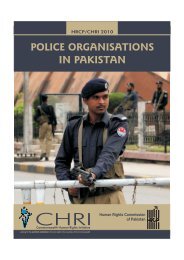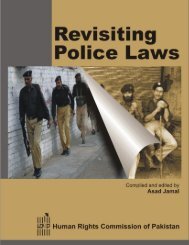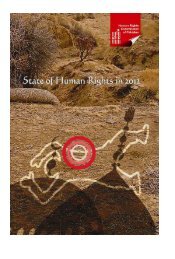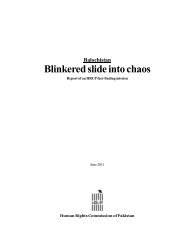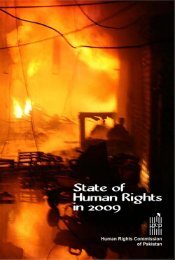Judical Action to end Bonded Labour - Human Rights Commission ...
Judical Action to end Bonded Labour - Human Rights Commission ...
Judical Action to end Bonded Labour - Human Rights Commission ...
Create successful ePaper yourself
Turn your PDF publications into a flip-book with our unique Google optimized e-Paper software.
Introduction<br />
I<br />
The judiciary has played a most significant role in the efforts aimed at eliminating the<br />
scourge of bonded labour that has been rampant in Pakistan for ages, the largest<br />
concentration of bonded labourers being found in the brick-kiln industry and in agriculture.<br />
The main features of bonded labour are that the whole family of a worker, including<br />
old men, women and small children, r<strong>end</strong>ers services <strong>to</strong> a brick-kiln owner or landlord for<br />
extremely low wages that are grossly inadequate for meeting its modest needs. Most of the<br />
workers have no shelter of their own and are thus obliged <strong>to</strong> stay close <strong>to</strong> the place of work<br />
in jhuggies on land provided by the employers, and this increases their dep<strong>end</strong>ence on brickkiln<br />
owners or landlords. Since wages are low the workers are obliged <strong>to</strong> borrow money from<br />
the employers <strong>to</strong> cover day-<strong>to</strong>-day expenses or <strong>to</strong> meet emergencies such as sickness,<br />
death or marriage in the family. Brick-kiln workers also need loans during the rainy season<br />
when brick-making is susp<strong>end</strong>ed for months on <strong>end</strong>. Although deductions for loans are<br />
regularly made from the workersí wages, the amount of the loan, called Peshgi (advance<br />
against wages), goes on increasing. A worker is not allowed <strong>to</strong> find another employment or<br />
residence unless he clears his debt. This is the essence of bondage and attempts <strong>to</strong> escape<br />
are foiled by force and the workers concerned can be harassed, beaten and <strong>to</strong>rtured, often<br />
with the help of the police. They can also be implicated in false criminal cases. Under this<br />
vicious system women are doubly vulnerable. In addition <strong>to</strong> the exploitation of their labour<br />
they are also subjected <strong>to</strong> sexual abuse. Another fac<strong>to</strong>r of the bonded labourersí vulnerability<br />
is the fact that a vast majority of brick-kiln workers are Christians and in agriculture in Sindh<br />
they mostly belong <strong>to</strong> the backward non-Muslim castes. 1<br />
Since the system of peshgi/loans lies at the root of the plight of bonded labourers<br />
they are often described as debt-slaves. Whatever the phrase used in this debate the use of<br />
bonded labour is manifestly a slavery-like practice.<br />
1. For an understanding of the bonded labour system, see the reports app<strong>end</strong>ed <strong>to</strong> the Supreme Court judgment in<br />
Darshan Masih case below, the Survey of <strong>Bonded</strong> <strong>Labour</strong> by Ali Ercelwan and M. Nauman for Pakistan Institute of <strong>Labour</strong><br />
and Research, <strong>Bonded</strong> <strong>Labour</strong> in Agriculture by Ali Karim for <strong>Human</strong> <strong>Rights</strong> Watch, and ILO publications, especially the<br />
Rapid Assessment Survey.<br />
--- i ---



